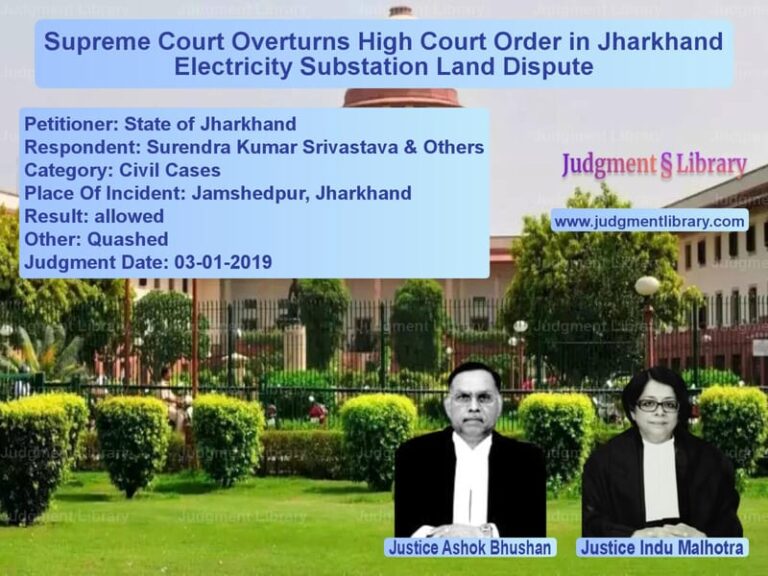Supreme Court Rules on Land Compensation in Punjab Acquisition Case
The Supreme Court of India, in Rameshwar Dass vs. The State of Punjab, ruled on the issue of compensation for landowners whose land was acquired for the construction of the Satluj-Yamuna Canal. The case centered on whether the compensation determined by the High Court was adequate or if the landowners were entitled to further enhancement.
Background of the Case
The case originated from land acquisition proceedings initiated by the State of Punjab under the Land Acquisition Act, 1894. The State issued a notification under Section 4 of the Act on March 29, 1988, acquiring 14.49 acres of land from nine villages for the purpose of canal construction. The notification was followed by a declaration under Section 6 on May 3, 1988.
The acquired land was located in the following villages:
- Jandpur
- Dharak Khurd
- Pamour
- Majat
- Matran
- Bhago Majra
- Siampur
- Mataur
- Manak Majra
Rameshwar Dass, the appellant, owned land in Bhago Majra village.
Compensation Determined by the Land Acquisition Officer
The Land Acquisition Officer (LAO), in an award dated August 21, 1990, fixed the compensation for the land as follows:
- Chahi (Irrigated land): Rs. 55,000 per acre
- Barani (Non-irrigated land): Rs. 55,000 per acre
- Gair Mumkin (Uncultivable land): Rs. 40,000 per acre
The landowners, including the appellant, found this compensation inadequate and sought a reference under Section 18 of the Act for enhancement.
Determination by the Reference Court
The Civil Court, in its award dated April 17, 1996, re-examined the compensation and revised the rates as follows:
- Chahi: Rs. 1,00,000 per acre
- Barani: Rs. 75,000 per acre
- Gair Mumkin: Rs. 55,000 per acre
Appeal Before the High Court
Unhappy with the compensation granted by the Civil Court, the landowners approached the Punjab and Haryana High Court. However, when the case was listed, none appeared on behalf of the appellant. The High Court decided the matter based on submissions made by the State’s counsel and relied on its decision in Hari Singh & Ors. vs. State of Punjab, delivered on July 1, 2013.
Based on the Hari Singh case, the High Court enhanced the compensation for land in Bhago Majra as follows:
- Chahi: Rs. 2,00,000 per acre
- Barani: Rs. 1,60,000 per acre
- Gair Mumkin: Rs. 1,20,000 per acre
Appeal Before the Supreme Court
The appellant, dissatisfied with the High Court’s decision, approached the Supreme Court, arguing that:
- The compensation for land in Bhago Majra should have been fixed at par with other villages.
- The potential of the land near Mohali and Chandigarh was not adequately considered.
- The compensation should have been further enhanced.
Arguments by the Respondent (State of Punjab)
The State countered that:
- The High Court had already granted fair compensation based on comparable cases.
- The appellant’s land was located farther from urban areas, justifying a 20% reduction in compensation compared to other villages.
- The High Court had used a consistent methodology in determining land value.
Supreme Court’s Observations
The Supreme Court analyzed the methodology used by the High Court in Hari Singh’s case and its application to the present case. The Court observed:
- The High Court had examined the land’s proximity to Chandigarh, quality, and other relevant factors before determining compensation.
- A uniform rate for all villages was not feasible, as land valuation depends on multiple location-based factors.
- Since no material evidence was presented to justify a higher rate for Bhago Majra, there was no ground to interfere with the High Court’s decision.
The Court stated:
“The High Court has fixed appropriate rates for the lands situated in each of the nine villages after considering their location and potentiality. We do not find any fundamental error in this approach.”
Final Judgment
The Supreme Court dismissed the appeal, holding that:
- The compensation awarded by the High Court was fair and appropriate.
- The methodology adopted by the High Court was just and proper.
- The appellant failed to provide any substantial basis for further enhancement.
The Court concluded:
“There is no merit in the appeal, and accordingly, it is dismissed.”
Conclusion
This ruling reaffirms the principle that land compensation must be determined based on multiple factors, including location, quality, and urban proximity. The Supreme Court upheld the High Court’s assessment, ensuring that landowners received a just and fair amount based on comparable cases.
Petitioner Name: Rameshwar Dass.Respondent Name: The State of Punjab.Judgment By: Justice Abhay Manohar Sapre, Justice Dinesh Maheshwari.Place Of Incident: Bhago Majra, Punjab.Judgment Date: 14-03-2019.
Don’t miss out on the full details! Download the complete judgment in PDF format below and gain valuable insights instantly!
Download Judgment: Rameshwar Dass vs The State of Punjab Supreme Court of India Judgment Dated 14-03-2019.pdf
Direct Downlaod Judgment: Direct downlaod this Judgment
See all petitions in Property Disputes
See all petitions in Landlord-Tenant Disputes
See all petitions in Damages and Compensation
See all petitions in Judgment by Abhay Manohar Sapre
See all petitions in Judgment by Dinesh Maheshwari
See all petitions in dismissed
See all petitions in supreme court of India judgments March 2019
See all petitions in 2019 judgments
See all posts in Civil Cases Category
See all allowed petitions in Civil Cases Category
See all Dismissed petitions in Civil Cases Category
See all partially allowed petitions in Civil Cases Category






